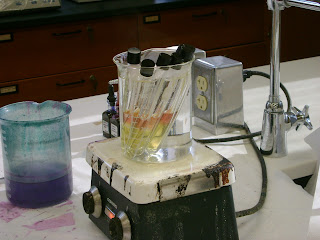Today, we checked the results from all the tests we performed on Tuesday. Our unknown bacteria was positive for gelatin hydrolysis. It also fermented glucose and sucrose, but not lactose, using the Durham tube tests. Our bacteria was negative for the Methyl red test, but positive for the Voges-Proskauer test. Our bacteria had a red slant and a yellow butt with a gas bubble for the TSIA test, which means only glucose was fermented. We will check the litmus milk test next week.
I am a sophomore nursing student at the Franciscan University of Steubenville, creating this blog for the lab component of my Medical Microbiology class!
Thursday, October 20, 2011
Tuesday, October 18, 2011
Lots of Inoculation!
 Today, we inoculated a LOT of test tubes to test for a variety of things. We are testing for gelatin hydrolysis, fermentation of the carbohydrates glucose, sucrose and lactose with a Durham tube, a Methyl Red/Voges-Proskauer test for fermentation of mixed acids, a Triple Sugar Iron (TSI) Agar test to see if the bacteria produced hydrogen peroxide, and a Litmus milk test to determine if the bacteria will utilize lactose, protein or litmus.
Today, we inoculated a LOT of test tubes to test for a variety of things. We are testing for gelatin hydrolysis, fermentation of the carbohydrates glucose, sucrose and lactose with a Durham tube, a Methyl Red/Voges-Proskauer test for fermentation of mixed acids, a Triple Sugar Iron (TSI) Agar test to see if the bacteria produced hydrogen peroxide, and a Litmus milk test to determine if the bacteria will utilize lactose, protein or litmus.
Friday, October 14, 2011
Oxygen Utilization and the Digestive Enzyme Test
 Yesterday, we checked the results of our oxygen utilization tests of our unknown bacteria. Both the thioglycollate broth and the GasPak tests indicated our unknown bacteria L is a facultative anaerobe, which means it can utilize oxygen when present, but that it is also capable of thriving without oxygen present.
Yesterday, we checked the results of our oxygen utilization tests of our unknown bacteria. Both the thioglycollate broth and the GasPak tests indicated our unknown bacteria L is a facultative anaerobe, which means it can utilize oxygen when present, but that it is also capable of thriving without oxygen present.Next, we made streak plates to test the digestive enzymes of our unknown bacteria. We streaked a starch agar plate, a lipid plate, and a casein plate (skim milk). After 24 hours, we came back to check the results. After adding Gram's iodine to the starch plate, we determined unknown L 25 was negative for starch hydrolysis. The casein plate also indicated our bacteria was negative for casein hydrolysis. The triglyceride plate was different, our bacteria indicated positive for lipid hydrolysis! We're getting so close to identifying it!
Enjoy the pictures!
Tuesday, October 11, 2011
Long Term Storage of Bacteria and Determining Oxygen Requirements
 Today, we made a tiny sample of our bacteria to store long term in the -80 degree freezer until the end of the semester. Using a pipettor, we combined 700 microliters of our environmental bacterial broth sample from last week and 300 microliters of the cryoprotectant glycerol. Then to determine the oxygen requirements of our unknown bacteria, we performed two different tests. First, we inoculated our sample in a thioglycollate broth, which turns pink when oxygen is present. We will determine the oxygen requirements next Thursday after examination. Then we made a streak plate of the unknown sample to use in the GasPak Anaerobic system. The GasPak eliminates oxygen using a chemical reaction and produces carbon dioxide. An indicator strip inside the GasPak turns blue when oxygen is present, and stays colorless when oxygen is absent. We will check those results Thursday as well. Enjoy the pictures!
Today, we made a tiny sample of our bacteria to store long term in the -80 degree freezer until the end of the semester. Using a pipettor, we combined 700 microliters of our environmental bacterial broth sample from last week and 300 microliters of the cryoprotectant glycerol. Then to determine the oxygen requirements of our unknown bacteria, we performed two different tests. First, we inoculated our sample in a thioglycollate broth, which turns pink when oxygen is present. We will determine the oxygen requirements next Thursday after examination. Then we made a streak plate of the unknown sample to use in the GasPak Anaerobic system. The GasPak eliminates oxygen using a chemical reaction and produces carbon dioxide. An indicator strip inside the GasPak turns blue when oxygen is present, and stays colorless when oxygen is absent. We will check those results Thursday as well. Enjoy the pictures!
Acid Fast and Endospore Staining!
Last week, our group split the tasks of acid fast and endospore staining our unknown samples. I completed the acid fast stain by using Ziehl-Neelson carbolfuchsin on a slide that was over a beaker of boiling water. After decolorizing that stain with acid-alcohol and covering it with methylene blue for two minutes, I used the microscope's oil immersion lens to determine that our unknown sample is non-acid fast, because the sample was purple. Annie also determined our unknown sample (L 25) had no endospores. 

Subscribe to:
Posts (Atom)
















